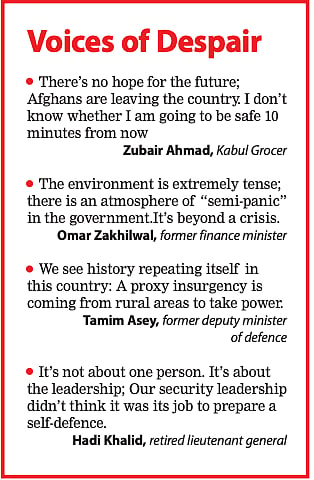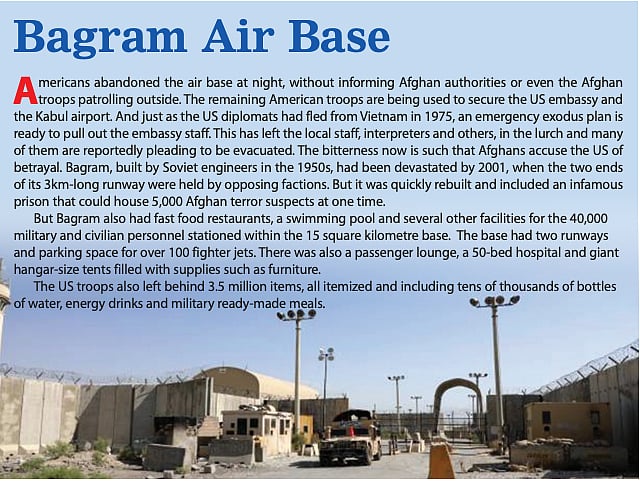Americans have refused to learn from Vietnam as they leave Afghans to their fate
Having failed to tame the Taliban and usher in stability, US has abandoned Afghans to their fate, writes Nazir Ahmad Razzaqi from Kabul, where the spectre of another civil war looms large

T he longest war in the history of the US cost trillions of dollars and the lives of thousands of US soldiers as the Taliban see themselves as victorious on the battlefield. In the current situation, Afghanistan is not a priority to the US, which has shifted its focus to China, Russia, Iran and North Korea. However, reactions to President Biden’s decision to withdraw troops from Afghanistan have been mixed with several US Senators calling it “reckless and a grave mistake because the enemies of the US are not defeated”.
The February 2020 agreement between the Taliban and the then US Secretary of State Mike Pompeo provided that the US would withdraw by May 1, 2021, in exchange for Taliban severing ties with al-Qaeda. Taliban then refused to attend further talks until foreign troops left Afghanistan. The Biden administration extended the withdrawal plan until September. But the Americans have all but left ahead of that schedule.
What are the possible post-withdrawal scenarios?
First Scenario: Preservation of Current Order: Preservation of the current situation including free elections and democratic values such as human rights, women’s rights and the supremacy of the Constitution is the least likely scenario; because Taliban’s ideology is way different from the current political order. This scenario envisages the Taliban joining the government and their armed men inducted in the Afghan army, their leaders integrated in the political system and sharing power. But then the Taliban is looking to establish an Islamic Emirate system in which law and order will be in accord with Sharia Law. The Taliban are war-oriented militants and now they have the upper hand on the battlefield. In this scenario, Afghan troops are the only deterrent to them achieving their goal.
Second Scenario: Deal Between the Mujahidin and the Taliban: The second possible scenario is a peace deal between the Taliban and the Mujahidin who are now part of the current political order. The Mujahidin within the system are resentful and far from happy with the government. They may well be inclined to share power with the Taliban. But division of power could be tricky. The TalibanMujahidin deal might be like the Iranian regime where a combination of Islamic Emirate and Republic are mixed. Such a regime could have its constitution and even elections. The probability of this scenario is higher because Mujahidin were fighting the USSR-supported government in Afghanistan and the Taliban continue to fight the US-supported government here. There are no signs of such negotiations, however. With a resurgent Taliban at the doorsteps of many provinces and the bitterness between the two rival groups in the last 18 years may also come in the way of power sharing.


Third Scenario: Prolonged Civil War: A large number of observers believe power sharing is unlikely between Taliban and the Mujahidin because the Taliban believe they are the victors. They expect fierce fighting to break out between the two at several places.
The other stakeholders may be less inclined to deal with the Taliban. India after investing three billion dollars is expected to back up Tajiks, Uzbeks, Hazaras and the educated Pashtuns who cannot work with Taliban because of the latter’s links with Pakistan. Even Central Asian countries including Russia will not put up with Taliban’s Emirate in their vicinity. So, a civil war appears inevitable and the most likely scenario.
Will Afghanistan turn into another Vietnam?
In 1965, the U.S troops were directly involved in the Vietnam war to support the South Vietnam democratic government. After eight years the then US President Richard Nixon took the responsibility to terminate the war. In a policy called “Vietnamization”, he started to train, equip and expand the combat capability and logistic and planning capacity of South Vietnam troops to be able to stand up against the communists in the North. In January 1973, the US representatives and South and North Vietnamese leaders signed a peace deal involving withdrawal of the US troops, release of prisoners, peaceful reunification and ceasefire. However, in March 1973, the ceasefire gave way to a full-fledged war and by January 1974, the South Vietnam government collapsed and the entire country fell into the hands of communists.
The same story is being repeated in Afghanistan. On February 29, 2020, the US and the Taliban signed a peace agreement in which both parties agreed on four main issues: Ceasefire, Intra-Afghan negotiations, Counterterrorism assurance and withdrawal of foreign troops. But barring the withdrawal of foreign forces, not one of the promises has been honoured. After a 20-year war against terror, the US and NATO troops are leaving Afghanistan without any tangible gain. The Taliban are now stronger and more enthusiastic than ever before to regain control. Reports of fullscale war everywhere and two to four districts falling to the Taliban every 24 hours dominate news coming out of Afghanistan.
The US and NATO promised to provide the incumbent Afghan Government with logistics, financial support and a lot more beyond the borders (intelligence, sanctions?). But they are similar to the promises made to South Vietnam by the Americans after they withdrew from Vietnam and the promises made by the Soviet Union to back up the Najibullah government in Afghanistan after the Russians went back.
Despite all the promises the probability of a repeat of the civil war is strong, especially when US intelligence believes that the government of Afghanistan will collapse within six months of the US withdrawal. Even President Biden in his meeting with the Afghan President said that the destiny of Afghanistan was in the hands of the Afghans, which in so many words indicated that he would not take any responsibility regarding the future of Afghanistan and its people.
(The writer is a lecturer of International Relations at the University of Afghanistan. Views are personal)
Follow us on: Facebook, Twitter, Google News, Instagram
Join our official telegram channel (@nationalherald) and stay updated with the latest headlines
